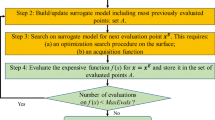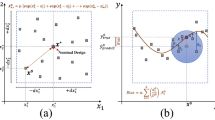Abstract
As a promising technique, surrogate-based design and optimization(SBDO) has been widely used in modern engineering design optimizations. Currently, static surrogate-based optimization methods have been successfully applied to expensive optimization problems. However, due to the low efficiency and poor flexibility, static surrogate-based optimization methods are difficult to efficiently solve practical engineering cases. At the aim of enhancing efficiency, a novel surrogate-based efficient optimization method is developed by using sequential radial basis function(SEO-SRBF). Moreover, augmented Lagrangian multiplier method is adopted to solve the problems involving expensive constraints. In order to study the performance of SEO-SRBF, several numerical benchmark functions and engineering problems are solved by SEO-SRBF and other well-known surrogate-based optimization methods including EGO, MPS, and IARSM. The optimal solutions, number of function evaluations, and algorithm execution time are recorded for comparison. The comparison results demonstrate that SEO-SRBF shows satisfactory performance in both optimization efficiency and global convergence capability. The CPU time required for running SEO-SRBF is dramatically less than that of other algorithms. In the torque arm optimization case using FEA simulation, SEO-SRBF further reduces 21% of the material volume compared with the solution from static-RBF subject to the stress constraint. This study provides the efficient strategy to solve expensive constrained optimization problems.
Similar content being viewed by others
References
LEMONGE A C C, BARBOSA H J C. An adaptive penalty scheme for genetic algorithms in structural optimization[J]. International Journal for Numerical Methods in Engineering, 2004, 59(5): 703–736.
HEDAR A R, FUKUSHIMA M. Derivative-free filter simulated annealing method for constrained continuous global optimization[J]. Journal of Global Optimization, 2006, 35(4): 521–549.
WANG G G, SHAN S. Review of metamodeling techniques in support of engineering design optimization[J]. Journal of Mechanical Design, 2007, 129(4): 370–380.
DYN N, LEVIN D, RIPPA S. Numerical procedures for surface fitting of scattered data by radial functions[J]. Siam Journal on Scientific and Statistical Computing, 1986, 7(2): 639–659.
FANG H B, HORSTEMEYER M F. Global response approximation with radial basis functions[J]. Engineering Optimization, 2006, 38(4): 407–424.
CRESSIE N. Spatial prediction and ordinary kriging[J]. Mathematical Geology, 1988, 20(4): 405–421.
YOUNIS A, DONG Z M. Trends, features, and tests of common and recently introduced global optimization methods[J]. Engineering Optimization, 2010, 42(8): 691–718.
JIN R, CHEN W, SIMPSON T W. Comparative studies of metamodeling techniques under multiple modeling critieria[J]. Structure and Multidisciplinary Optimization, 2001, 23(1): 1–13.
GUTMANN H M. A radial basis function method for global optimization[J]. Journal of Global Optimization, 2001, 19(3): 201–227.
LEARY S J, BHASKAR A, KEANE A J. Global approximation and optimization using adjoint computational fluid dynamics codes[J]. AIAA Journal, 2004, 42(3): 631–641.
YOUNG A, CAO C, PATEL V, et al. Adaptive control design methodology for nonlinearin control systems in aircraft applications[J]. Journal of Guidance, Control, and Dynamics, 2007, 30(6): 1770–1782.
BOOKER A J. Design and analysis of computer experiments[C]// Proccedings of the 7th AIAA/USAF/NASA ISSMO Symposium on Multidisciplinary Analysis and Optimization, Chicago, Illinois, USA, September 2–6, 1998: AIAA-98-4757.
SIMPSON T W, MISTREE F. Kriging models for global approximation in simulation-based multidisciplinary design optimization[J]. AIAA Journal, 2001, 39(12): 2233–2241.
JONES D R, SCHONLAU M, WELCH W J. Efficient global optimization of expensive black-box functions[J]. Journal of Global Optimization, 1998, 13(4): 455–492.
SASENA M. J, PAPALAMBROS P, GOOVAERTS P. Exploration of metamodeling sampling criteria for constrained global optimization[J]. Engineering Optimization, 2002, 34(3): 263–278.
ALEXANDROV N M, DENNIS J E, LEWIS R M, et al. A trust-region framework for managing the use of approximation models in optimization[J]. Structrual Optimization, 1998, 15(1): 16–23.
GANO S E, RENAUD J E, MARTIN J D, et al. Update strategies for kriging models used in variable fidelity optimization[J]. Structural and Multidisciplinary Optimization, 2006, 32(4): 287–298.
HAFTKA R T. Combining global and local approximations[J]. AIAA Journal, 1991, 29(9): 1523–1525.
WANG G G, DONG Z M, AITCHISON P. Adaptive response surface method a global optimization scheme for approximation-based design problems[J]. Engineering Optimization, 2001, 33(6): 707–733.
WANG G G. Adaptive response surface method using inherited latin hypercube design points[J]. Journal of Mechanical Design, 2003, 125(2): 210–220.
WONG L M, WANG G G. Development of an automatic design and optimization system for industrial silencers[J]. Journal of Manufacturing Systems, 2003, 22(4): 327–339.
PANAYI A P, DIAZ A R, SCHOCK H J. On the optimization of piston skirt profiles using a pseudo-adaptive response surface method[J]. Structural and Multidisciplinary Optimization, 2009, 38(3): 317–330.
WANG G G, SIMPSON T W. Fuzzy clustering based hierarchical metamodeling for design space reduction and optimization[J]. Engineering Optimization, 2004, 36(3): 313–335.
WANG L Q, SHAN S Q, WANG G G. Mode-pursuing sampling method for global optimization on expensive black-box functions[J]. Engineering Optimization, 2004, 36(4): 419–438.
SHARIF B, WANG G G, ELMEKKAWY T Y. Mode pursuing sampling method for discrete variable optimization on expensive black-box functions[J]. Journal of Mechanical Design, 2008, 130(2): 1–11.
MULLER J, SHOEMAKER C A, PICHE R. SO-MI: a surrogate model algorithm for computationally expensive nonlinear mixed-integer black-box global optimization problems[J]. Computers & Operations Research, 2013, 40(5): 1383–1400.
KITAYAMA S, ARAKAWA M, YAMAZAKI K. Sequential approximate optimization using radial basis function network for engineering optimization[J]. Optimization and Engineering, 2011, 12(4): 535–557.
CONN A R, LE D S. Use of quadratic models with mesh-adaptive direct search for constrained black box optimization[J]. Optimization Methods & Software, 2013, 28(1): 139–158.
LONG T, LIU L, PENG L. Global optimization method with enhanced adaptive response surface method for computation-intensive design problems[J]. Advanced Science Letters, 2012, 5(2): 881–887.
LONG T, LIU L, PENG L, et al. Aero-structure coupled optimization of high aspect ratio wing using enhanced adaptive response surface method[C]//12th AIAA Aviation Technology, Integration, and Operations (ATIO) Conference and 14th AIAA/ISSM, Indianapolis, Indiana, 17–19 September, 2012: AIAA-2012-5456.
ZHU H G, LIU L, LONG T, et al. Global optimization method using SLE and adaptive RBF based on fuzzy clustering[J]. Chinese Journal of Mechanical Engineering, 2011, 25(4): 768–775.
LI Y L, LIU L, LONG T, et al. Metamodel-based global optimization using fuzzy clustering for design space reduction[J]. Chinese Journal of Mechanical Engineering, 2013, 26(5): 928–939.
PENG L, LIU L, LONG T, et al. An efficient truss structure optimization framework based on CAD/CAE integration and sequential radial basis function metamodel[J]. Structural and Multidisciplinary Optimization, 2014, 50(2): 329–346.
QUEIPO N V, HAFTKA R T, SHYY W, et al. Surrogate-based analysis and optimization[J]. Progress in Aerospace Sciences, 2005, 41(1): 1–28.
FORRESTER A I J, KEANE A J. Recent advances in surrogate-based optimization[J]. Progress in Aerospace Sciences, 2009, 45(1–3): 50–79.
JIN R C, CHEN W, SUDJIANTO A. An efficient algorithm constrcting optimal design of computer experiment[J]. Journal of Statistical Planning and Inference, 2005, 134(1): 268–287.
JOHNSON M E, MOORE L M, YLVISAKER D. Minmax and maximin distance design[J]. Journal of Statistical Planning and Inference, 1990, 26(2): 131–148.
MCKAY M D, BECKMAN R J, CONOVER W J. A comparison of three methods for selecting values of input variables in the analysis of output from a computer code[J]. Technometrics, 2000, 42(1): 55–61.
MORRIS M D, MITCHELL T J. Exploratory designs for computational experiments[J]. Journal of Statistical Planning and Inference, 1995, 43(3): 381–402.
FANG K T, MA C X, WINKER P. Centered L-2-discrepancy of random sampling and latin hypercube design, and construction of uniform designs[J]. Mathematics of Computation, 2002, 71(237): 275–296.
KAZEMI M, WANG G G, RAHNAMAYAN S, et al. Metamodel-based optimization for problems with expensive objective and constraint functions[J]. Journal of Mechanical Design, 2011, 133(1): 1–7.
PENG L, LIU L, LONG T. Study of sequential radial basis function for computation-intensive design optimization problem[C]//14th AIAA/ISSM Multidisciplinary Analysis and Optimization Conference, Indianapolis, Indiana, Sep 17–19, 2012: AIAA-2012-5689.
VIANA F, HAFTKA R. Surrogate-based optimization with parallel simulations using the probability of improvement[C]//13th AIAA/ISSMO Multidisciplinary Analysis and Optimization Conference, Fort Worth, TX, USA, Sep 2010: AIAA-2010-9392.
VIANA F, HAFTKA R, WATSON L. Why not run the efficient global optimization algorithm with multiple surrogates?[C]//51st AIAA/ASME/ASCE/AHS/ASC Structures, Structural Dynamics, and Materials Conference, Orlando, FL, USA, Apr 2010: AIAA-2010-3090.
Author information
Authors and Affiliations
Corresponding author
Additional information
Supported by National Natural Science Foundation of China(Grant Nos. 51105040, 11372036), Aeronautical Science Foundation of China(Grant Nos. 2011ZA72003, 2009ZA72002), Excellent Young Scholars Research Fund of Beijing Institute of Technology(Grant No. 2010Y0102), and Foundation Research Fund of Beijing Institute of Technology(Grant No. 20130142008)
PENG Lei, born in 1987, is currently a PhD candidate at School of Aerospace Engineering, Beijing Institute of Technology, Beijing, China. He received his bachelor degree from Beijing Institute of Technology, China, in 2009. His research interests include the theories and application of multidisciplinary design optimization, and flight vehicle conceptual optimization design.
LIU Li, born in 1964, is currently a professor at Beijing Institute of Technology, China. She received her PhD degree from Beihang University, China. Her research interests include flight vehicle conceptual design, flight vehicle engineering structural optimization design, multidisciplinary design optimization, flight vehicle guidance and control.
LONG Teng, born in 1982, is currently an associate professor at Beijing Institute of Technology, China. He received his PhD degree from Beijing Institute of Technology, China, in 2009. His research interests include flight vehicle preliminary design, theories and applications of multidisciplinary design optimization, multiple UVAs cooperative control and decision.
GUO Xiaosong, born in 1989, is currently a master candidate at School of Aerospace Engineering, Beijing Institute of Technology, Beijing, China. His research field is flight vehicle conceptual design.
Rights and permissions
About this article
Cite this article
Peng, L., Liu, L., Long, T. et al. Sequential RBF surrogate-based efficient optimization method for engineering design problems with expensive black-box functions. Chin. J. Mech. Eng. 27, 1099–1111 (2014). https://doi.org/10.3901/CJME.2014.0820.138
Received:
Revised:
Accepted:
Published:
Issue Date:
DOI: https://doi.org/10.3901/CJME.2014.0820.138




